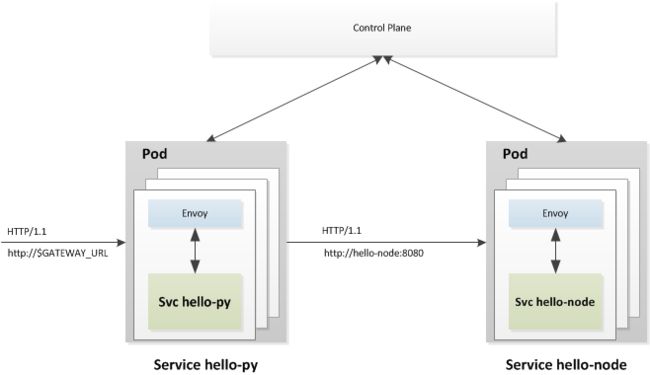- 0.1. 一. 安装环境
- 0.2. 二. 安装istio
- 0.2.1. 获取Istio release , 我本地使用的为0.4.0版本
- 0.2.2. 进入istio目录
- 0.2.3. 添加istioctl 到PATH
- 0.2.4. 安装, 这里为了方便安装了不带TLS的版本
- 0.2.5. (可选)安装Istio-Initializer, 可以自动注入sidecar
- 0.3. 三. 创建应用和镜像
- 0.3.1. 创建hello-node应用和镜像
- 0.3.2. 创建hello-py应用和镜像
- 0.4. 四. 部署和发布应用到k8s
- 0.4.1. 新建文件
hello-istio.yaml - 0.4.2. 使用kubectl 将服务发布到Kubernetes
- 0.4.3. 访问验证
- 0.4.4. 清除
- 0.4.1. 新建文件
原文地址https://my.oschina.net/ganity/blog/1616866
Istio 是Service Mesh下一代微服务架构的一个完整的解决方案,本文在本地实验环境中开发和部署了一个简单的示例应用.
本例子中使用了两个应用,hello-node和hello-py. 调用关系如下 
0.1. 一. 安装环境
使用Minikube的本地实验环境, 系统为centos7.0, 安装参考https://yq.aliyun.com/articles/221687
0.2. 二. 安装istio
可以参考https://istio.io/docs/setup/kubernetes/quick-start.html
0.2.1. 获取Istio release , 我本地使用的为0.4.0版本
curl -L https://git.io/getLatestIstio | sh -
0.2.2. 进入istio目录
cd istio-0.4.0
0.2.3. 添加istioctl 到PATH
export PATH=$PWD/bin:$PATH
0.2.4. 安装, 这里为了方便安装了不带TLS的版本
kubectl apply -f install/kubernetes/istio.yaml
0.2.5. (可选)安装Istio-Initializer, 可以自动注入sidecar
kubectl apply -f install/kubernetes/istio-initializer.yaml
查看是否安装正常,看istio-pilot, istio-mixer, istio-ingress三个服务是否部署
kubectl get svc -n istio-system
查看pods
kubectl get pods -n istio-system
这样istio就安装完成了
0.3. 三. 创建应用和镜像
本例子中使用了两个应用,hello-node和hello-py. hello-node为nodejs应用,提供一个接口返回一个JSON对象; hello-py为python应用,调用hello-node提供的接口获取JSON对象,简单封装后并返回到外部调用者(curl/浏览器或其他)
0.3.1. 创建hello-node应用和镜像
参考的kubernetes官方文档内容https://kubernetes.io/docs/tutorials/stateless-application/hello-minikube/#create-your-nodejs-application
- 创建hello-node应用
创建一个目录nodeserver, 并创建一个server.js文件内容如下
var http = require('http');
var handleRequest = function(request, response) {
console.log('Received request for URL: ' + request.url);
response.writeHead(200, {'Content-Type': 'application/json'});
var data = {
"name":"nodejs-istio",
"value":"Hello World!"
};
response.end(JSON.stringify(data));
};
var www = http.createServer(handleRequest);
www.listen(8080);
- 创建镜像在
nodeserver目录下新建Dockerfile,内容如下
FROM node:6.9.2
EXPOSE 8080
COPY server.js .
CMD node server.js
为了使用Minikube的docker环境执行
eval $(minikube docker-env)
当不再使用minikube环境时可以使用eval $(minikube docker-env -u)恢复
- 使用docker build构建镜像
docker build -t hello-node:v1 .
0.3.2. 创建hello-py应用和镜像
参考istio官方GitHub中的bookinfo例子https://github.com/istio/istio/blob/master/samples/bookinfo/src/productpage/productpage.py
- 创建hello-py应用
新建文件夹pythonserver, 并新建文件productpage.py,内容如下, 拿官方例子改的
#!/usr/bin/python
from flask import Flask, request, render_template, redirect, url_for
import simplejson as json
import requests
import sys
from json2html import *
import logging
import requests
# These two lines enable debugging at httplib level (requests->urllib3->http.client)
# You will see the REQUEST, including HEADERS and DATA, and RESPONSE with HEADERS but without DATA.
# The only thing missing will be the response.body which is not logged.
try:
import http.client as http_client
except ImportError:
# Python 2
import httplib as http_client
http_client.HTTPConnection.debuglevel = 1
app = Flask(__name__)
from flask_bootstrap import Bootstrap
Bootstrap(app)
def getForwardHeaders(request):
headers = {}
user_cookie = request.cookies.get("user")
if user_cookie:
headers['Cookie'] = 'user=' + user_cookie
incoming_headers = [ 'x-request-id',
'x-b3-traceid',
'x-b3-spanid',
'x-b3-parentspanid',
'x-b3-sampled',
'x-b3-flags',
'x-ot-span-context'
]
for ihdr in incoming_headers:
val = request.headers.get(ihdr)
if val is not None:
headers[ihdr] = val
#print "incoming: "+ihdr+":"+val
return headers
# The UI:
@app.route('/')
@app.route('/index.html')
def index():
headers = getForwardHeaders(request)
result = {
"code": 200,
"data": getProductDetails(headers),
"author": "hello-py",
"version": "1.0.0"
}
return json.dumps(result), 200, {'Content-Type': 'application/json'}
# Data providers:
def getProductDetails(headers):
try:
url = "http://hello-node:8080"
res = requests.get(url, headers=headers, timeout=3.0)
except:
res = None
if res and res.status_code == 200:
return res.json()
else:
status = res.status_code if res is not None and res.status_code else 500
return {'error': 'Sorry, product details are currently unavailable for this book.'}
if __name__ == '__main__':
if len(sys.argv) < 2:
print( "usage: %s port" % (sys.argv[0]))
sys.exit(-1)
p = int(sys.argv[1])
print( "start at port %s" % (p))
app.run(host='0.0.0.0', port=p, debug=True, threaded=True)
其中url = "http://hello-node:8080"这里指定该请求需要路由到hello-node服务
- 在
pythonserver目录下新建requirements.txt文件
requests
flask
flask_json
flask_bootstrap
json2html
simplejson
gevent
- 构建镜像, 在
pythonserver目录新建Dockerfile
FROM python:2.7-slim
COPY requirements.txt ./
RUN pip install --no-cache-dir -r requirements.txt
COPY productpage.py /opt/microservices/
COPY templates /opt/microservices/templates
COPY requirements.txt /opt/microservices/
EXPOSE 9080
WORKDIR /opt/microservices
CMD python productpage.py 9080
- 构建
docker build -t hello-py:v1 .
完成后可以通过docker images查看是否成功
0.4. 四. 部署和发布应用到k8s
0.4.1. 新建文件hello-istio.yaml
apiVersion: v1
kind: Service
metadata:
name: hello-node
labels:
app: hello-node
spec:
ports:
- port: 8080
name: http
selector:
app: hello-node
---
apiVersion: extensions/v1beta1
kind: Deployment
metadata:
name: hello-node-v1
spec:
replicas: 1
template:
metadata:
labels:
app: hello-node
version: v1
spec:
containers:
- name: hello-node
image: hello-node:v1
imagePullPolicy: IfNotPresent
ports:
- containerPort: 8080
---
##################################################################################################
# Productpage services
##################################################################################################
apiVersion: v1
kind: Service
metadata:
name: hello-py
labels:
app: hello-py
spec:
ports:
- port: 9080
name: http
selector:
app: hello-py
---
apiVersion: extensions/v1beta1
kind: Deployment
metadata:
name: hello-py-v1
spec:
replicas: 1
template:
metadata:
labels:
app: hello-py
version: v1
spec:
containers:
- name: hello-py
image: hello-py:v1
imagePullPolicy: IfNotPresent
ports:
- containerPort: 9080
---
###########################################################################
# Ingress resource (gateway)
##########################################################################
apiVersion: extensions/v1beta1
kind: Ingress
metadata:
name: gateway
annotations:
kubernetes.io/ingress.class: "istio"
spec:
rules:
- http:
paths:
- path: /
backend:
serviceName: hello-py
servicePort: 9080
---
这里定义了两个service,一个网关
0.4.2. 使用kubectl 将服务发布到Kubernetes
kubectl apply -f hello-istio.yaml
- 注: 如果没有安装 Istio-Initializer, 需要手动注入sidecar
kubectl apply -f <(istioctl kube-inject -f samples/bookinfo/kube/bookinfo.yaml)
完成后可以查看看Pods
kubectl get pods
查看service
kubectl get svc
查看是否有istio-proxy
kubectl get pod hello-node-v1-5f8c79f65f-zb24c -o jsonpath='{.spec.containers[*].name}'
或者查看describe
kubectl describe po hello-node-v1-5f8c79f65f-zb24c
0.4.3. 访问验证
当pods中的STATUS为Running状态时,可以访问服务,由于本地环境使用minikube所以需要如下命令获取访问地址
export GATEWAY_URL=$(kubectl get po -l istio=ingress -n istio-system -o 'jsonpath={.items[0].status.hostIP}'):$(kubectl get svc istio-ingress -n istio-system -o 'jsonpath={.spec.ports[0].nodePort}')
使用curl请求
curl $GATEWAY_URL
结果
![]()
0.4.4. 清除
kubectl delete -f hello-istio.yaml
到此本地istio简单示例的开发到发布完成
本文源代码https://github.com/ganity/istio-kubernetes-example.git


